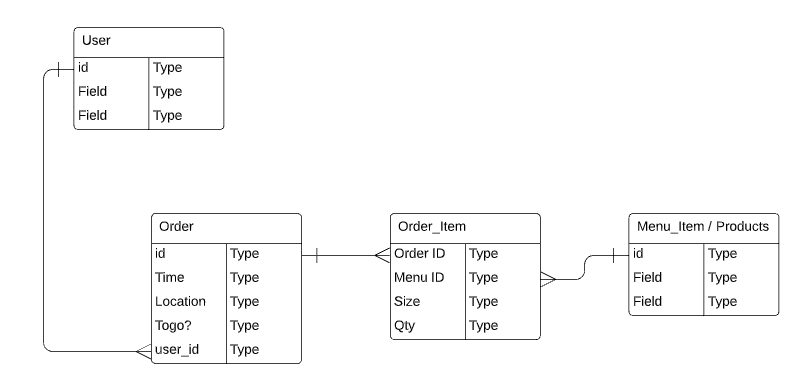Working with associations was the most difficult part of building Central Perk, my Ruby on Rails application. has_many and belongs_to relationships made sense, but the addition to many-to-many—has_many through—relationships are where it got weird. I ran into several issues while building my application and this is how I solved them.
Model Behavior
For my project, I planned on three models. Users (baristas), orders and menu items (products). The relationship would like this:

With those models, programmatically, I wanted to be able to do the following:
-
Create a new order and automatically associate it with a user.
shannon.orders.create -
Be able to see all orders that belong to a user.
shannon.orders -
See all menu_items (products) in a specific order.
order.menu_items
After setting up my models, everything seemed to be working up until order.menu_items. Currently, an Order with an attribute of :menu_items could only have one value. Meaning, one MenuItem per Order. Can you imagine if you had to get back in line and start a new order for each item you wanted to buy at a coffee shop?
This is where a has_many :through relationship came in.
Many to Many
If I wanted more than one menu item, per order, the result of order.menu_items needed to be an array. This is where the OrderItem model comes in.
OrderItem acts as a join table, with foreign keys to the Order and MenuItems models. In this example, think of each OrderItem record has a transaction instance, representing one Order and one MenuItem at a time.
An Order would essentially be a colletion of all OrderItem records with the same :order_id. I was a step closer to figuring out what I needed.
But?
At first, an OrderItem model made sense.
Until, it didn’t.
Would I need to call order.order_items.menu_items to see all the items in that order? My app had a User model too. How do you build a has_many through a relationship when there are more than three models?
In reality, has_many through only works with three models. But, through other associations, it extends the functionality of those models. If I wanted to know how many MenuItems were in the first order, created by a specific user I could call something like this: user.orders.first.menu_items.count.
Visually, I thought of the relationships between the four models as looking like this:

This was making sense!
I would not need to reference OrderItems directly. ActiveRecord does that work for me. Since an Order has many OrderItems, referencing the Order would gives me direct access to MenuItems.
My updated models now looked like this:
class User < ApplicationRecord
has_secure_password
has_many :orders
end
class Order < ApplicationRecord
belongs_to :user
has_many :order_items
has_many :menu_items, through: :order_items
end
class OrderItem < ApplicationRecord
belongs_to :order
belongs_to :menu_item
end
class MenuItem < ApplicationRecord
has_many :order_items
has_many :orders, through: :order_items
end
Params
With the associations complete, I needed a form to create the Order object. At first, everything seemed to be working. But after looking closer at the console, I realized the transaction was getting rolled back and Order was not saving to the database.
I noticed the :menu_items_id key was listed in my strong params, but I was getting a :menu_items_ids is not permitted error.
To try and resolve this, I worked in the console, testing things out, bit by bit until I could pinpoint where I was getting stuck. In the console, I could successfully do the following.
-
Create an order.
order = Order.create(user_id: 1, name_for_pickup: "Rachel", menu_item_ids: [1,2,3]) -
View the value of menu_items.
order.menu_items # [1,2,3] -
Add an item to an order.
order.menu_items << item -
Save the order.
order.save
Then it hit me.
Ruby was right in not permitting the menu_item_ids param. I thought I needed to create an order. Instead, I needed to create an order, find the menu items by id (menu_items_id, which was the unpermitted params) and shovel them into the array. I updated my create order method.
From this:
def create
@order = Order.create(order_params)
if @order.save
redirect_to order_path(@order)
else
render :new
end
end
To this
def create
@order = Order.create(order_params)
items_to_add = params[:order][:menu_item_ids]
items_to_add.each do |item_id|
if item_id != ""
item_id = item_id.to_i
item_to_add = MenuItem.find_by_id(item_id)
@order.menu_items << item_to_add
end
end
if @order.save
redirect_to order_path(@order)
else
render :new
end
end
And it worked!
Lessons Learned
In summary, if you are running into issues with object relationships, try the following:
Verify that the params are correct
Typos can instantly cause object creation to fail. Pluralization like menu_item_id vs menu_item_ids are also something to look out for. All params are strings, which may cause downstream effects if you are expecting an integer or boolean.
All model attributes are listed in strong params
Strong params help to prevent users from injecting harmful data into your database via the form. If strong params lists only :name, :email and :password can be submitted in a User model, the transaction will fail (and not write to your database, yay!) if an attribute of :not_a_hacker was within your params.
Use .create! instead of .create when testing
create! will give more information into what validations may be causing errors. For example, in my app, an Order must have as User (barista) id associated with it. Running Order.create() in the console would not tell me much, but running Order.create!() would print out an error like A User must exist.
Append .valid? to objects
An object may be updating, but, is it saving properly to the database? For example, if order referenced Order.create() (an empty object, which will not validate because there is no :user_id), adding .valid? will return false.
Summary
Model associations can be difficult and frustrating, but not impossible!
Resources
--
The post Debugging Has Many, Through Relationships in Ruby on Rails appeared first on Shannon Crabill's Blog.
Photo by Annie Spratt on Unsplash










Top comments (6)
What’s an email developer?
I love the article. Thank you.
Thanks for reading :)
An email developer is someone who codes and tests the emails like the ones you get from DEV, or brands like Starbucks or Target. Unlike designing for the web, there are no standards for how emails render across browsers, operating systems, devices, etc, so most emails are coded with tables and inline CSS to ensure they render ok. Email developers may also be responsible for any logic behind an email (like if an email includes your name or account number) and launching the email.
Maybe I'll make that it's own post. 🤔
Most definitely a good post for that, would be nice!!!
Why i am not surprised. You are in the flatiron bootcamp. Keep it up!!!
Exactly what I needed
I love the article! Thanks for sharing!